Monkland Canal
Introduction
This former canal ran east from Port Dundas to Coatbridge and on to Faskine, near Calderbank. The canal carried coal from the collieries east of the city to Glasgow and served the growing iron industry which led to the development of Coatbridge around a bridge over the canal. Construction took some time. There was a flight of locks, duplicated as traffic grew and inclined plane shiplift at Blackhill. Portions remain today but the canal is not open.
Dates
| / /1770 | Monkland Canal Canal and associated waggonways authorised. Construction begins at Sheepford (later Sheepford Locks). Engineer; James Watt. |
| / /1773 | Monkland Canal Project partly abandoned due to lack of money as the Ayr Bank is liquidated, canal only runs from Sheepford (later Sheepford Locks) to Blackhill (later Blackhill Locks). |
| / /1783 | Monkland Canal Extended west from Blackhill (later Blackhill Locks) to Townhill Basin. There were no locks at Blackhill at this stage and transhipment over land was required. The canal portions were 96ft apart vertically. |
| / /1790 | Monkland Canal Andrew Stirling of Drumpellier (Drumpeller) and William Stirling and Company take over canal and decide to extend it west to the Forth and Clyde Canal in Glasgow and east to Calderbank. Extensions authorised. |
| / /1790 | Monkland Canal Canal extended eastwards via the Sheepford Locks. |
| / /1790 | Cut of Junction Act passed for connecting canal between Port Dundas Basin on the Forth and Clyde Canal and Townhead Basin on the Monkland Canal. |
| 17/10/1791 | Cut of Junction Link between Port Dundas Basin on the Forth and Clyde Canal and Townhead Basin on the Monkland Canal opened to through traffic with the passage of the first vessel. The canal was built at the expense of the F&C but to the depth of the Monkland. |
| / /1792 | Monkland Canal Dam built on North Calder Water to control water flowing into the canal. |
| / /1793 | Monkland Canal
Forth and Clyde Canal Monkland Canal west and east portions are joined by a new section of canal at the Blackhill Locks. |
| / /1794 | Monkland Canal Construction complete. |
| / /1799 | St Rollox Chemical Works Charles Tennant and Charles Mackintosh open the St Rollox Chemical Works (Tennants Works), on the 'Cut of Junction' between the Forth and Clyde Canal and Monkland Canal in Glasgow, an alkali works for the production of bleaching liquor and powder. |
| / /1800 | Legbrannock Railway Opened by William Dixon (Senior) to move coal from the Legbrannock Colliery, on the Woodhall Estate, to the Monkland Canal. (Alternative date 1813.) |
| / /1813 | Legbrannock Railway Opened from Legbrannock Colliery to the Monkland Canal by William Dixon (Senior). |
| / /1813 | Monkland Canal Alterations to details of original Act. |
| / /1819 | Monkland Canal At Faskine Basin the Vulcan, the first iron-hulled passenger boat, is launched. |
| / /1824 | Calder Ironworks Waggonway Opened to connect works to Monkland Canal. |
| / /1824 | Calder Ironworks Waggonway Opened from Calder Iron works to Monkland Canal. |
| / /1824 | Cut of Junction
St Rollox Canal Charles Tennant & Co, of the nearby St Rollox Chemical Works, form a canal from the Cut of Junction, near the Monkland Canal's Townhead Basin, running north and then east to serve land they owned east of Castle Street and their chemical works. The land was to be sold in lots and the serving of the lots with a canal connected to the Forth and Clyde Canal and Monkland Canal would assist in the sales. The new owners of the land would jointly be responsible for maintaining the canal, Tennant would retain the canal solum. |
| / /1825 | Charles Tennant Charles Tennant, one of the promoters of the Garnkirk and Glasgow Railway, visits the Stockton and Darlington Railway with his family. Local suppliers and mines further afield via the Monkland Canal were struggling to meet the coal demands of the St Rollox Chemical Works. |
| / /1826 | Calder Waggonway This waggonway linking the Calder Iron Works and Monkland Canal is replaced by siding from Monkland and Kirkintilloch Railway. It is partly retained until the 1860s. |
| / /1828 | Alexander Baird Construction of Gartsherrie Iron Works begins, a blast furnace on the east side of the Monkland Canal's Gartsherrie branch. |
| / /1828 | Monkland Canal Gartsherrie, Hornock and Summerlee Branch of canal opened, to serve the under construction Gartsherrie Iron Works, Summerlee Iron Works (after 1836) and Howes Basin. |
| /04/1835 | Monkland Canal Short branch canal to Dundyvan Basin under construction. |
| / /1836 | Monkland Canal Short Dundyvan Basin branch opened. |
| / /1842 | Cut of Junction The portion of canal between St Rollox Depot/Glasgow (Townhead) (Garnkirk and Glasgow Railway) and Port Dundas Basin is improved by increasing the canal depth. This portion was originally only 4ft deep (depth of the Monkland Canal) which prohibited the larger coal boats of the Forth and Clyde Canal reaching St Rollox. The railway depot was rebuilt and enlarged in the 1840s. |
| / /1843 | William Baird & Co 16 blast furnaces now in operation at Gartsherrie Iron Works with an annual capacity of 100,000 tons, 8 new blast furnaces opened on the west bank of the Monkland Canal's Gartsherrie branch. |
| 04/07/1843 | Drumpeller Railway Line authorised with permission for the Monkland Canal to buy the railway. |
| / /1846 | Monkland CanalForth and Clyde Canal Monkland Canal authorised to be taken over by the Forth and Clyde Canal. |
| 01/11/1849 | Buchanan Street Extension (Caledonian Railway) Glasgow Buchanan Street opened on a new extension which branched off at Milton Junction and ran parallel to the original line before passing under it and the Monkland Canal in a tunnel. English trains via the Caledonian Railway main line are diverted from South Side [CR] to the new more suitable station. |
| / /1850 | Monkland Canal Traffic reaches its peak. |
| / /1850 | Monkland Canal Blackhill Incline opened to carry empty barges uphill alongside the Blackhill Locks. This incline saved considerable amount of water which would otherwise be lost to lock operation. |
| / /1851 | Drumpeller Railway
Forth and Clyde Canal The Drumpeller Railway is purchased by the Forth and Clyde Canal (not the Monkland Canal with which it connected). |
| / /1860 | Monkland Canal Baillieston Shed in use at Nackerty on railway. |
| / /1865 | City of Glasgow Union Railway
Monkland Canal Authorisation for a deviation of the Monkland Canal. |
| / /1867 | Forth and Clyde Canal
Monkland Canal
Forth and Cart Canal
Grangemouth Railway (Forth and Clyde Canal Company)
Drumpeller Railway
Caledonian Railway Forth and Clyde Canal (Forth and Clyde Navigation) including the Port Dundas Basin branch, Monkland Canal, Forth and Cart Canal and various assets such as the Grangemouth Railway (Forth and Clyde Canal Company) and Drumpeller Railway, bought by the Caledonian Railway to compete with the North British Railway in the Forth - Clyde Valley. The North British Railway is given running powers over the Grangemouth Railway (Forth and Clyde Canal Company). Caledonian Railway given running powers over the Stirlingshire Midland Junction Railway to Larbert Junction |
| / /1867 | Monkland Canal Dundyvan Basin Branch of the Monkland Canal absorbed by the Caledonian Railway. |
| / /1867 | Monkland Canal
Caledonian Railway The Monkland Canal is absorbed by the Caledonian Railway. |
| / /1872 | Monkland and Kirkintilloch Railway New alignment opens with a bridge which takes the line over Monkland Canal, West Canal Street and Bank Street in central Coatbridge. The junction with the Sheepford Branch (Monkland and Kirkintilloch Railway) is taken out and a new alignment laid in to the south which crossed the Dundyvan Basin canal branch. |
| / /1872 | Whitelaw Fountain In memory of Alexander Whitelaw, partner in William Baird & Co, who organised the raising of the Monkland and Kirkintilloch Railway onto a bridge in 1847, rather than crossing the road over the Monkland Canal in Coatbridge with a level crossing. |
| / /1873 | Monkland Canal The Vulcan, the first iron-hulled passenger boat, is withdrawn from service. |
| / /1882 | Airdrie Branch (Caledonian Railway) Lock Street Viaduct built over the Monkland Canal to extend the line from Whifflet Upper to Airdrie [CR]. |
| / /1882 | Monkland Canal Authorisation to abandon a portion of canal at Blochairn. By the Blochairn Iron Works, allowing the Blochairn Steel Works Branch (Caledonian Railway) to occupy its site on the south side of the works. |
| / /1887 | Monkland Canal Blackhill Incline falls out of use. |
| / /1893 | Monkland Canal Rebuilding of Millburn Bridge (Robertson's Bridge) authorised. Millburn Chemical Works to north east. Craigpark Works to south east. |
| / /1940 | Monkland Canal Canal abandoned. |
| / /1960 | Monkland Canal Piped, filled in and the M8 Motorway built over the top from Easterhouse to Glasgow. |
Portions of line and locations
This line is divided into a number of portions.
Glasgow to Faskine
Blackhill and Sheepford locks to be added.
This was the Glasgow terminus of the Garnkirk and Glasgow Railway. It was on the north bank of the Monkland Canal just east of the Port Dundas Basin. The depot was chiefly a mineral depot with several sidings serving coal staithes on the canal, very much expanded in the 1840s after the site ceased to serve passengers - a curve in the line betrays where the westwards extension began. ...
More detailsSee also
Garnkirk and Glasgow Railway
Port Dundas Branch (Caledonian Railway)
This large chemical works, once the largest in the World, was in the north of Glasgow (229 Castle Street). It started by producing bleaching chemicals for cloth. The works was built on the north bank of the Forth and Clyde Canal / Monkland Canal Cut of Junction (the link between the canals). It was most famous for it's huge chimney dating from 1842, the 'St Rollox Stalk', which was 435.5 ...
More detailsSee also
Garnkirk and Glasgow Railway
This works opened in 1855 for the production of wrought iron, later malleable iron and later still steel. It was located on the north bank of the Monkland Canal, used to deliver coal to the site. The works was served from Garngad to the north west by sidings from the City of Glasgow Union Railway of 1875, which bordered the works to the west. It was also served from [[Blochairn ...
More detailsSee also
Blochairn Steel Works Branch (Caledonian Railway)
On the partly landscaped land to the south side of the M8 at Riddrie, just east of the gasometers and the junction with the M80, is the site of the Blackhill Incline.
...
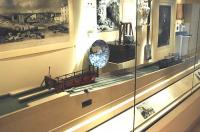
Ewan Crawford 08/10/2005
This canal basin was located on the Monkland Canal at Cuilhill Gullet. From the south, it was approached by the mineral Drumpeller Railway and the location was a transshipment point.
...
See also
Drumpeller Railway
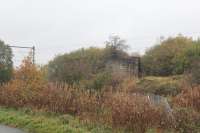
Alastair McLellan 05/11/2017
This iron works, in the south west of Coatbridge, was opened in by Robert Addie, Robert Miller and Patrick Rankin. A range of blast furnaces were built in an east-west orientation on the north bank of the Luggie Burn.
...
See also
Langloan Railway
This iron works, constrained between the Glasgow, Garnkirk and Coatbridge Railway (to the west) and the Gartsherrie Branch of the Monkland Canal (to the east) was opened by Wilsons and Co and John Neilson.
...
See also
Summerlee Iron Co
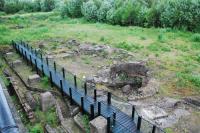
Ewan Crawford 27/06/2010
This basin is today a tranquil location on the former Gartsherrie Branch of the Monkland Canal. It was formerly a transshipment point between the Monkland and Kirkintilloch Railway and the canal, having coal drops on its eastern side served from Howes on the M&K.
...
See also
Monkland and Kirkintilloch Railway
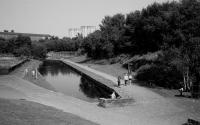
Bill Roberton //2003
This was a large iron works to the north of Coatbridge. It was built by William Baird & Co in 1828. The location was chosen due to the quantity of blackband ironstone, coal and limestone in the area. The works produced forge quality iron which was internationally famous.
...
See also
Gartsherrie Ironworks and Railways (William Baird & Co)
Monkland and Kirkintilloch Railway
Originally built as a transshipment point between the Monkland Canal and Monkland and Kirkintilloch Railway One main use of it was as the northern outlet for coal from the Wishaw and Coltness Railway. Between the two basins were coal staithes. A small basin lay between the M&K and GG&C lines, served by lines from the M&K and Dundyvan Iron Works.
...
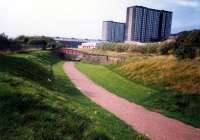
Ewan Crawford //1987
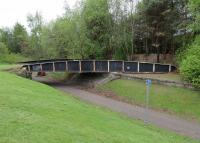
Alastair McLellan 06/05/2019
Formed by William Dixon (Senior) of Govanhill (1753-1822) in 1801 with David Mushet. The works was served by the 'Dixon's Cut' of the Monkland Canal.
...

Ewan Crawford //

Ewan Crawford //
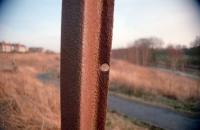
Ewan Crawford //2001





